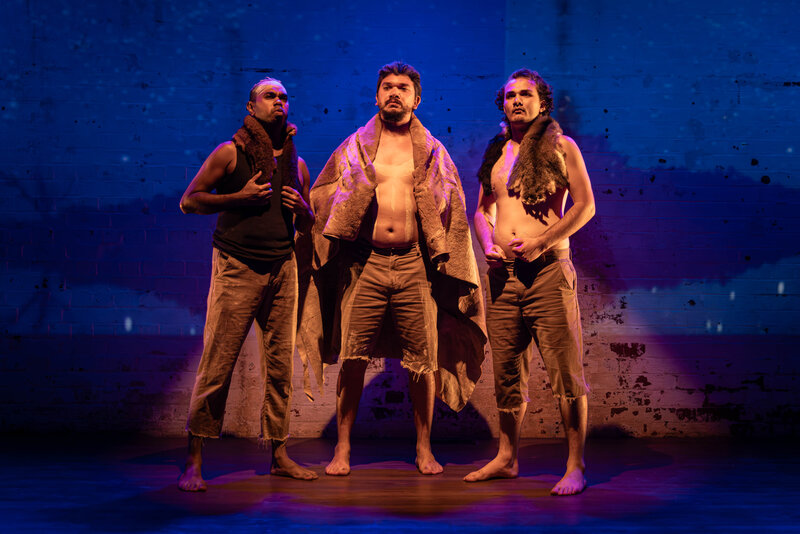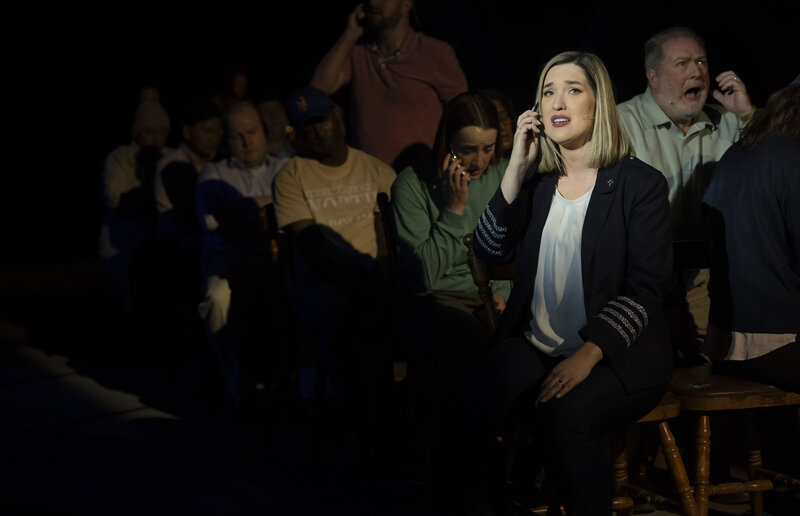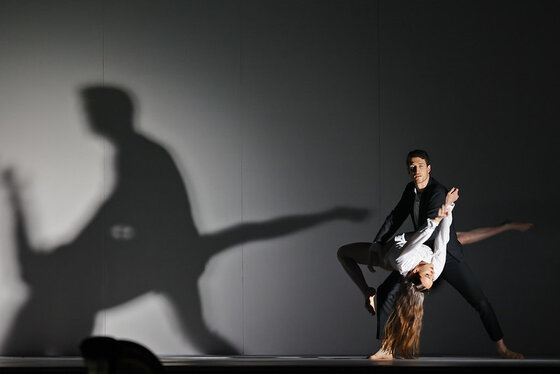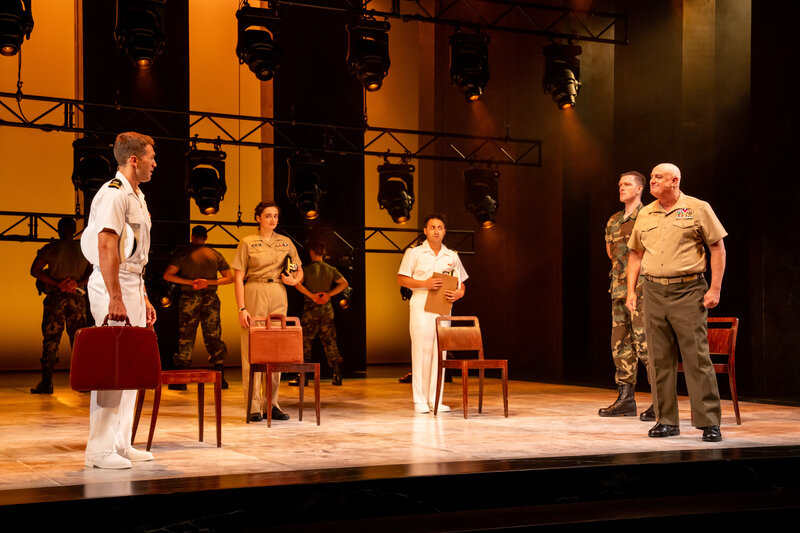This is a new production of Carmen, by John Bell for Opera Australia (OA), opening the 2016 Winter Season. A major event , then.
I had had, as a kid, a copy of an old 78 recording of Lawrence Tibbett, singing his ‘swaggering’ Escamillo’s Toreador Song – played ad nauseam , according to my siblings, again and again (the other side of the recording was of the Te Deum from Tosca, too, played again and again). My first opera theatre Carmen was a revival of the famous 1972 Metropolitan Opera production, made immortally famous (perhaps), but, definitely, unforgettable – securely, burnt into my theatrical musings (museum) – because of the spectacular and ‘outrageous’ Design and Lighting by Josef Svoboda.
 Carmen Jones, the 1954 musical film, was probably the first time I was able to contextualise the Toreador song. But, now, in 2016, I have many, many wisps of impression of the opera, floating through my memory banks from many, many productions, theatrical and cinematic. Its revival is so common, lying in the repertory of most opera companies, sitting securely in the famous trio of assured money makers for the opera, the so-called ABC: Aida, Boheme, Carmen. Certainly, our Australian company has counted on all three of those operas to re-charge its monied coffers (it seems), played ad nauseam, according to some of my friends of opera. This is the third production under the auspices of OA in the last eight years. The exciting and sexually charged productions directed, firstly, by Francesca Zambello – seen in 2008 and revived as late as 2014 – and, secondly, for the Handa Opera on Harbour Summer productions, in 2013, by Gale Edwards, both, hardly able to be forgotten.
Carmen Jones, the 1954 musical film, was probably the first time I was able to contextualise the Toreador song. But, now, in 2016, I have many, many wisps of impression of the opera, floating through my memory banks from many, many productions, theatrical and cinematic. Its revival is so common, lying in the repertory of most opera companies, sitting securely in the famous trio of assured money makers for the opera, the so-called ABC: Aida, Boheme, Carmen. Certainly, our Australian company has counted on all three of those operas to re-charge its monied coffers (it seems), played ad nauseam, according to some of my friends of opera. This is the third production under the auspices of OA in the last eight years. The exciting and sexually charged productions directed, firstly, by Francesca Zambello – seen in 2008 and revived as late as 2014 – and, secondly, for the Handa Opera on Harbour Summer productions, in 2013, by Gale Edwards, both, hardly able to be forgotten.
So, just why we needed a new production of Carmen does not sit easily with my attempt to rationalise the Opera Australia’s protests of ‘poverty’. Surely, I rationalise, the money expended on this new Carmen, could, ought to have been allocated for a new Australian opera (at least in budgetary considerations). It does sit, oddly, weirdly, in my estimation, to note, that it was the State Opera of South Australia (budgeting, relatively, on the ‘smell -of-an oily-rag’) that premiered a new Australian opera, Cloudstreet, by George Palmer, in May, this year – which I saw in workshop in Sydney in 2013 – shaped, guided, directed by Gale Edwards (one of the most consistent directors of big money makers for OA: the often, nationally seen La Boheme, for one; as well as her highly praised Salome). I understand that OA has not shown any interest in presenting Cloudstreet, this enthusiastically received work to their audiences. A tragedy, really, for opera audiences around the country – as it is likely that OA would be the only company that could do this. The money spent on this new Carmen could surely have introduced this (any!) new Australian work as an investment for its future. The OA revives regularly, Ms Edwards’ productions noting their appeal to their audiences: La Boheme, annually, it seems, and next year her Carmen on the harbour (is it true that she has not been asked, to even re-stage it? Even though she actually lives in Sydney?). Don’t you think, to bring Cloudstreet, an adaptation of one of Australia’s literary favourites, a ‘child’ of Ms Edwards’ known genius to their audiences would surely be a ‘no-brainer’ for the OA, looking for not only artistic (and historic) credibility, and possibly, a money-maker (philistinism, creeping necessarily in) for Mr Hassall (Chief Executive), Mr Terracini (Artistic Director) and the Board of Directors, of OA led by Chairman, David Mortimer? Surely?
Ms Zambello’s and Ms Edwards’ Carmen were what Mr Bell’s isn’t: steaming with the vitality of the siren calls, scents of sexual attraction, of the ‘dreaded’ life force of our biology, – high-lighted in the writings of the nineteenth century philosophers, Schopenhauer and Nietzsche – of events of a visceral disturbance. Mr Bell’s Carmen is staged well, professionally. Competently, safely and clearly. But is, in production comparison, to the two women and their passion for the story and music, a relatively generalised and cool (intellectually cold) staging of the Bizet temperament, with symbolic gestural and emblematic imagery, that is in experience, ‘representative’, rather than ‘passionately visceral’, to thrill and disturb us. There is, surely, nothing so primal as sex and death? And Carmen is that if nothing else. The sexual tension generated in this new production of Carmen, this opera, a forerunner of the ‘verismo’ movement of the late nineteenth century – 1875 (read portrayals of normal people – middle or lower class) – which caused an initial baulking to recognising the brilliance of this work, is made, mostly, by the greatly familiar and exotic score by Bizet, and, ultimately (thankfully) in the late passionate commitment to the singing of the Don Jose (Yonghoon Lee) and the Carmen (Clementine Margaine). This production is experienced as an intellectual solution by an experienced stager, and his collaborators, of theatre work, but not as a thrilling sexual identification with the material. There is a little pleasure in this production but it is certainly not visceral. There is a loss, here, with this Carmen, especially, after the Zambello and Edwards’ offers.
No intellectual justification and execution that this production can make in setting this work in an imagined Cuba, to help bring a contemporary relevance, to engage us with the story, can be made, especially, as a substitution for a production and performers that should generate a truth of a real ‘living’ experience of this extraordinary (sexually iconic) story.
The initial setting design by Michael Scott-Mitchell of a rundown roller-doored Spanish square is impressive in its realistic re-creation. (An infamous commercial musical appropriation of the famous Toreador Song, which we, of a certain generation can sing, came flooding back to me). It, however, became boring to view as the background for each of the other locations for the other three acts, no matter the set dressings provided – an unstable food van (Act Two) and a ‘put-put’ truck that makes a slow exit, trailing smoke (Act Three) – some of that detail.
Similarly, the costume solution, by Teresa Negroponte, for all but the soldiers, are startling, but ultimately garish and ‘ugly’ in their crowded and regular reappearance – they are visually of value as impact in spectacularly diminishing terms over the night’s viewing. One hardly feels sexual heat in any of the choices. This is especially true in the dressing of Ms Margaine as Carmen, who looks like a blowsy ‘spinster’ with late aspirations for sex, throwing herself at anything with a pulse – the last act costume being some redemption of elegance for the actor/singer if not for the reality of the story’s needs. The choices for Carmen are, especially, difficult to balance with the Design choices for the sexy costuming of Frasquita (Jane Ede) and Mercedes (Margaret Trubiano), who, unfortunately, surround, closely their Carmen.The visual contrasts are not complimentary for this Carmen. And how is it that Micaela has only one costume and only one pair of shoes – even to climb the mountain to the gypsy camp?! For me, another neglect of detail of Design.
 The choreography, by Kelley Abbey, has been contemporarily contextualised as a Cuban possibility, and are a major feature of the production, attempting to generate as much sexual heat as possible in a terribly unsexy visual design. That the choreography, as wonderful as it is, sometimes has the cumulative affect of the finesse and energy for show numbers in a casino show on the Gold Coast, with the addition of some four or five kids break-dancing streetwise as an entertainment bonus, is no fault of Ms Abbey. They have been, urgently, exposed by the director as far down stage on the awkwardly designed front wedge of floor space, as often as possible – it is very ‘in-yer-face’.
The choreography, by Kelley Abbey, has been contemporarily contextualised as a Cuban possibility, and are a major feature of the production, attempting to generate as much sexual heat as possible in a terribly unsexy visual design. That the choreography, as wonderful as it is, sometimes has the cumulative affect of the finesse and energy for show numbers in a casino show on the Gold Coast, with the addition of some four or five kids break-dancing streetwise as an entertainment bonus, is no fault of Ms Abbey. They have been, urgently, exposed by the director as far down stage on the awkwardly designed front wedge of floor space, as often as possible – it is very ‘in-yer-face’.
The consistently successful part of the night is the music made by the orchestra under the baton of conductor, Andrea Molino, and the singing. Ms Margaine gives a thrilling, if too careful, range of efforts to the demands of Bizet, but it is the ultimate passionate vocal lift-off that Mr Lee made in the final act that was the pay-off for those of us who stayed after the interval. Natalie Aroyan sang Micaela well enough, if dramatically, dully – no balancing power of ‘virtue’ to Carmen represented in this performance! Adrian Tamburini makes a very good impression with his singing and acting of Zuniga. But, there could not have been a less felicitous choice of the Escamillo (Michael Honeyman), who does not really have the vocal heft to claim the Toreador Song (where are you Mr Tibbett? – ah, my childhood expectation), or any visible sexual charisma at all to be a rival for Carmen’s attentions. Mr Lee – sexual charisma and ability to sing thrillingly his Bizet responsibilities – won hands down in both areas, and it certainly dulled the night for us further, as one could not logically comprehend Carmen’s shift of choice, from this Don Jose to that Escamillo.
There is nothing really wrong about this production of Carmen by OA, except its utter safeness, and one can see similar achievements in other provincial opera houses around the world, I am sure. It is just that this production, since it is replacing two other recent Carmen productions by the OA, which were superior in all ways, is a great disappointment and an apparent waste of valuable resources of the company. So distancing was it, that while, on stage, another man murdered another woman brutally, the contemporary issue of violence against women was able to have some space in my consciousness while watching it. Recently, having been engaged in debate with the social, sexual relevance of Shakespeare’s The Taming of the Shrew, and its justification for being presented in the contemporary theatre, with many suggesting it should not be presented – that there was no justification for showing such violence- one could not help ruminate how little repertoire of classic opera could be presented if the brutalisation of women became a reason to not present the work on the opera stages. Maybe, we can see the death knell of the opera as a relevant cultural contributor, while we watch productions of this calibre, which are so, relatively, a disengaging experience of the genre. Emotional response so diminished that cool intellectualisation can come into very active play on many fields of contention.
Company: Opera Australia
Venue: Joan Sutherland Theatre, Sydney Opera House
Dates: 16 June – 12 August 2016
Kevin Jackson
For more of Kevin Jackson’s theatre reviews, check out his blog at Kevin Jackson’s Theatre Diary

David Edwards is the former editor of The Blurb and a contributor on film and television




